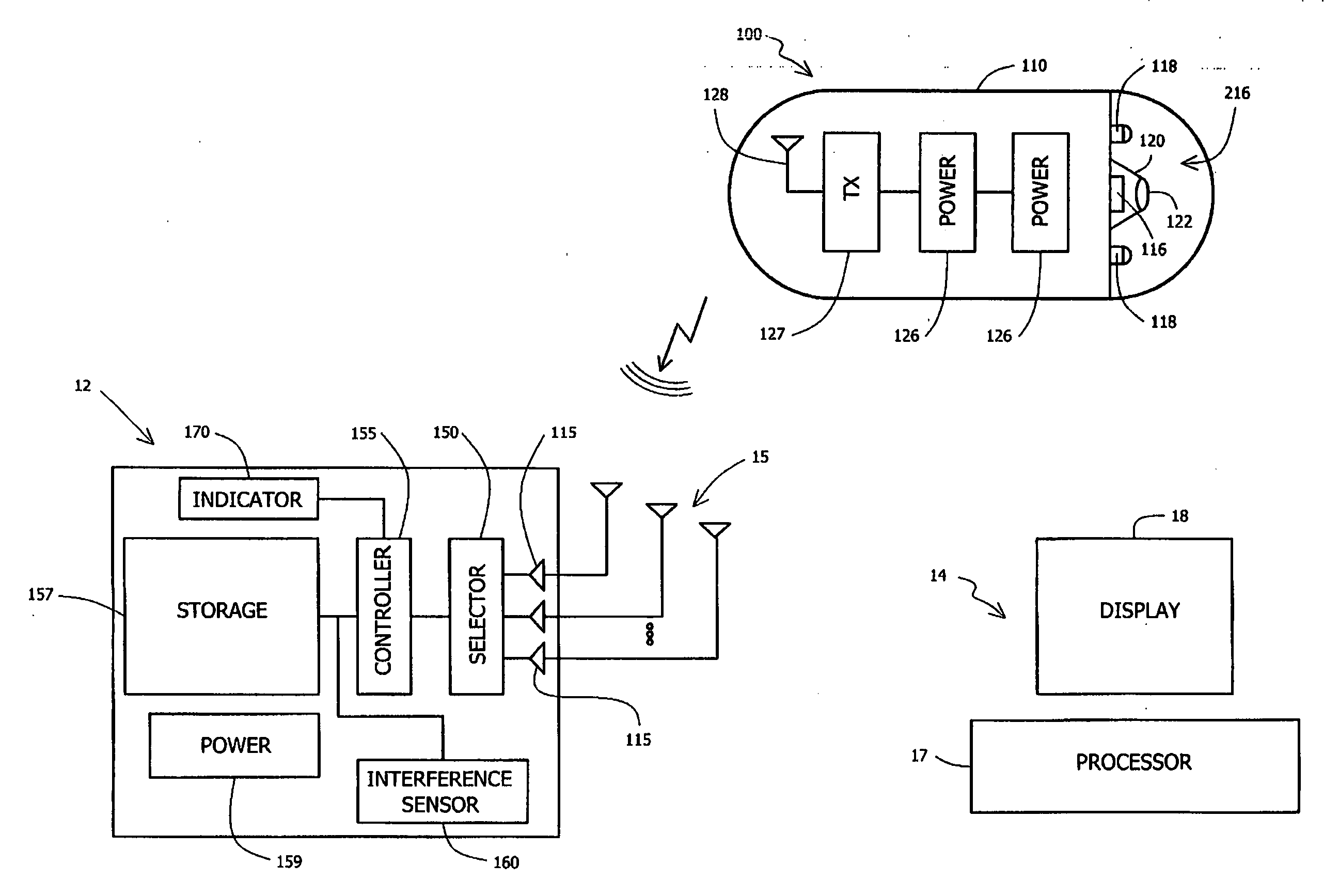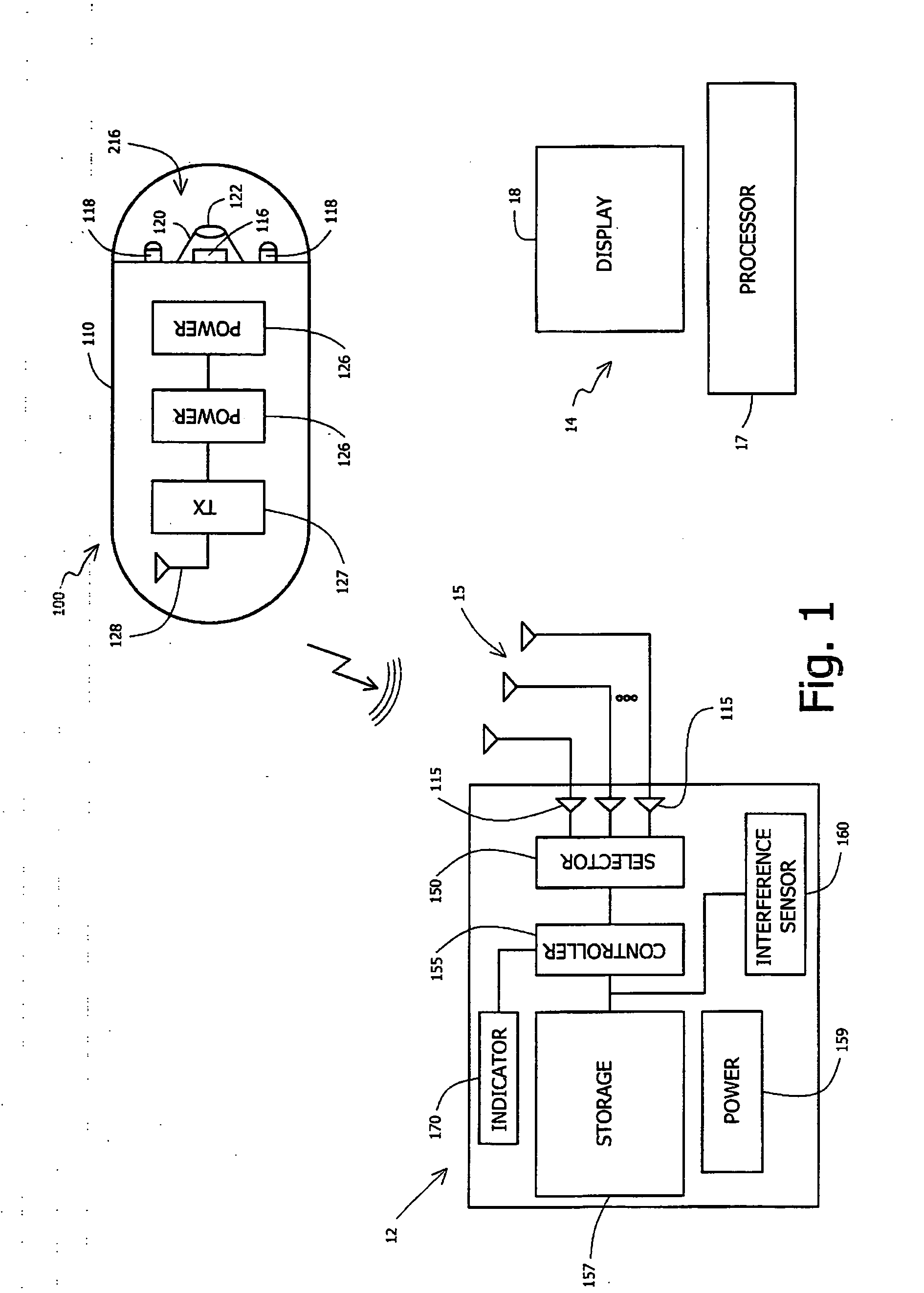Method and system for communication with an ingestible imaging device
a technology of ingestible imaging and communication method, which is applied in the field of ingestible imaging device, can solve the problems of data that may be important in diagnosis loss or corruption due to interferen
- Summary
- Abstract
- Description
- Claims
- Application Information
AI Technical Summary
Benefits of technology
Problems solved by technology
Method used
Image
Examples
second embodiment
[0031] According to the present invention, an interference sensor 260 may be included within ingestible device 200. For example, an antenna 128 may, e.g., during an idle time or period of transmission, receive and / or pick up signals in the frequency range of antenna 128 from the surrounding environment that may be interfering signal. The strength of signals picked up, e.g. during the idle period of transmission, may be detected by an interference sensor 260. Interference sensor 260 may be for example a RSSI component to detect the strength of a signal received by antenna 128. An amplifier 215 may be used to amplify the received signal prior to detecting the signal strength. In one example the amplifier 215 and / or the interference sensor 260 may be integral to the transmitter 127. In alternate examples, the interference sensor 260 may be separate or integral to other components, e.g. the imager 116 or other components in the ingestible device 200. Data detected by interference sensor...
first embodiment
[0038] Interference detection for the uplink channel via antennas 15 may be similar to the discussion presented in reference to FIG. 1 describing the present invention. In one embodiment of the present invention, control unit 155 may prompt recorder 312 during a period when the uplink channel is normally idle or during an idle time between frames, to pick up signals that may be present in the surrounding environment. Signal selector 150, may for example select the strongest signal picked up from the plurality of antennas 15. Interference sensor 160 may determine the signal strength. The signal strength detected may be recorded in storage unit 157.
[0039] Indicator 170 may alert a patient or health profession that the patient is situated in an area where interference signals are being picked up the recorder 312. For example, indicator 170 may be a visual indicator, e.g. an LED, an audio indicator, e.g. a buzzer or other indicator e.g. a vibrator that may give indication to the patient...
fourth embodiment
[0046] According to the present invention, an interference sensor 560 for the downlink channel may be included and or contained within ingestible device 400, e.g. within the housing 110 of the ingestible device 400. For example, an antenna 128b may, e.g., during an idle period of the downlink channel, receive and / or pick up signals in the frequency range of antenna 128b from the surrounding environment that may be interfering with proper communication through the downlink channel. The strength of signals picked up, e.g. during the idle period of transmission, may be detected by an interference sensor 560. Interference sensor 560 may be for example a RSSI component to detect the strength of a signal received by antenna 128b. An amplifier 561 may be used to amplify the received signal prior to detecting the signal strength. In one example the amplifier 561 and / or the interference sensor 560 may be integral to the transceiver 427. In alternate examples, the interference sensor 560 may ...
PUM
 Login to View More
Login to View More Abstract
Description
Claims
Application Information
 Login to View More
Login to View More - R&D
- Intellectual Property
- Life Sciences
- Materials
- Tech Scout
- Unparalleled Data Quality
- Higher Quality Content
- 60% Fewer Hallucinations
Browse by: Latest US Patents, China's latest patents, Technical Efficacy Thesaurus, Application Domain, Technology Topic, Popular Technical Reports.
© 2025 PatSnap. All rights reserved.Legal|Privacy policy|Modern Slavery Act Transparency Statement|Sitemap|About US| Contact US: help@patsnap.com



